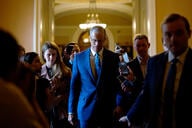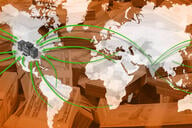You have /5 articles left.
Sign up for a free account or log in.
WASHINGTON, D.C. – An official with the U.S. Agency for International Development outlined future directions for engagement with universities at a session at the Association of Public and Land-grant Universities' Annual Meeting here on Sunday. Among the takeaways: the agency is increasingly interested in working directly with universities -- including those in foreign countries -- rather than through intermediaries, and in tasking higher education institutions to identify their own solutions to global development challenges.
In September, U.S.A.I.D. announced it would not be renewing its contract with Higher Education for Development -- an association-led intermediary through which it has funded development-oriented partnerships between U.S. universities and institutions abroad -- in favor of working directly with the universities themselves. HED's existing contract expires in 2015.
Eric Postel, the assistant administrator for U.S.A.I.D.'s Bureau of Economic Growth, Education and Environment, prefaced his remarks Sunday by saying that two ideas would permeate his speech.
“First, that U.S.A.I.D.’s relationship with institutions of higher education is longstanding, special, and has been and will continue to be critical to global development,” he said. “And secondly that times are changing. That the challenges are enormous and that the ever-expanding constellation of actors mandate that we approach our partnerships differently.” (By "ever-expanding constellation," Postel was referring to growth in development-related activity on the part of private sector players, including nongovernmental organizations, churches and corporations.)
Postel described a few different examples of higher education partnerships that he thinks are emblematic of U.S.A.I.D.’s shifting orientation, including the Higher Education Solutions Network, through which it funds interdisciplinary "development labs" at seven universities to identify solutions to global challenges such as food security, and the Wildlife Trafficking Tech Challenge, a call for researchers to offer their ideas for combating the problem.
“That’s one of the things that we’re trying to do differently,” he said. “In the recent past, U.S.A.I.D. would identify what it thought were the problems, identify what it thought were the solutions, and say who wants to do that? But more and more, through tech challenges, grant challenges and other things, we’re teaming up with others to identify what the problem is and then saying who’s got the idea, who’s got the solution. And that’s a shift in the mindset.”
In this vein, Postel described a push to make more of the agency's program data available online, where outside researchers can gain access to it.
“We want to do more things where we work directly with universities, including local universities in developing countries, and all of you -- not through intermediaries,” Postel said.
An internal task force convened by Postel last year identified a number of recommendations regarding the agency's engagement with higher education. “We’re hoping to hear soon as a result of one of the recommendations on a White House appointment on a senior higher education coordinator for the agency,” he said. “This person, hopefully a former senior leader of an APLU institution or another institution of higher education in the United States, will be the front door for our engagement with all of you. We know sometimes U.S.A.I.D. can be pretty opaque. We want to have one place where anybody can go and get answers to questions and have a rich dialogue. We hope that that person will also be an internal champion for doing more and better work with higher education.”
Postel concluded by saying that the opportunities for collaboration between U.S.A.I.D. and higher education are expanding, both in terms of the dollar amount of funding for partnerships and the diversity of them.
“There's no question that U.S.A.I.D.’s engagement with universities has increased” in recent years, said M. Peter McPherson, APLU’s president (and a former U.S.A.I.D. administrator himself). “There's more money and more relationships.” In his speech, Postel said that U.S.A.I.D. provided $436 million in direct funding to U.S. and foreign universities in 2011, with 83 percent of that money going to American universities.
As for the planned movement away from working with an intermediary, “The reason for HED was in large part as a way to conveniently relate to universities,” said McPherson, who added that it’s not unusual for government agencies or for foundations, for that matter, to change the way they relate to their grantees. But having decided that it wants to have more direct relationships with universities, the issue for U.S.A.I.D. going forward, McPherson said, will be ensuring that the mechanisms are in place to make that happen.




